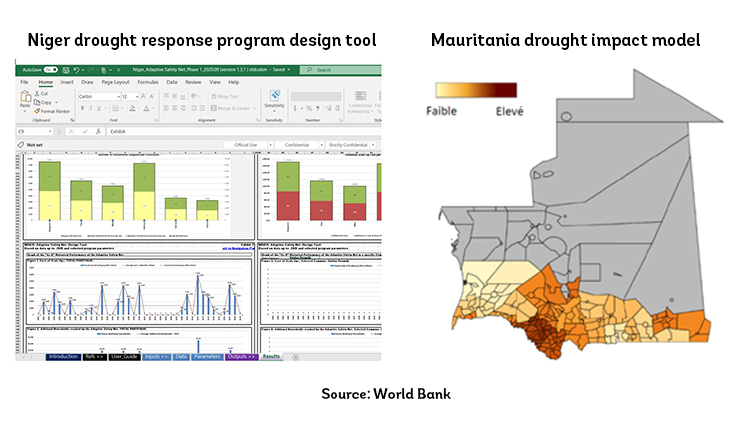5 myths about Disaster Risk Financing for adaptive social protection in the Sahel

Across Africa, adaptive social safety nets are on the rise. Building on traditional safety nets that provide cash assistance and other services to poor households on a regular basis, they respond to shocks – mostly via rapid cash payments to affected households. Adaptive safety nets have supported tens of millions of people across Africa during the COVID-19 pandemic. Increasingly, they also protect households against other types of shocks such as droughts and floods.
Disaster risk financing (DRF), part of financing shock response programs, sets up pre-arranged instruments, such as national disaster funds or sovereign insurance programs.
Successful DRF instruments have been implemented mainly in Southeast Asia and Latin America. However, the conditions in the West African Sahel are vastly different, with chronic food insecurity and high vulnerability, and payments delivery infrastructure, data availability, and government fiscal space often limited.
A recent policy note evaluates what these different conditions mean for DRF for adaptive social protection in the Sahel. It identifies five common DRF myths that do not or only partially apply in the Sahel.
Myth 1: DRF is only about setting up financial instruments
Despite the name, DRF is about more than financing. As examples from the Sahel show, DRF analytical tools can help to prioritize risks, plan response activities, develop activation triggers, analyze historical cost, and compare different financing strategies. For example, in Niger, a DRF tool was developed showing how adjustments in adaptive safety net design would have impacted the number of beneficiaries and program cost over time. In Mauritania, a model estimating the impact of drought on food insecurity was developed and used to prioritize affected communes to add to the national social registry.

Myth 2: Establishing DRF instruments should be an urgent priority for countries in the Sahel
Before establishing risk financing mechanisms, Sahel countries should ensure that safety net programs reach a significant share of the vulnerable population, are robust, and can scale up quickly. Adaptive safety nets such as those in Kenya and Malawi integrated shock financing arrangements into their program design from the start. However, they could rely on broad coverage and tested delivery mechanisms. In the Sahel, only Mauritania and Senegal have achieved broad coverage of their safety net programs. Besides, digital payment delivery, social household registries, and ID systems remain nascent in countries such as Chad, Niger, Burkina Faso, and Mali. Without either coverage or delivery capacity, potential shock financing will not be effective.
Myth 3: DRF reduces the need for donors to support countries in responding to disasters
DRF strategies in the Sahel should recognize that the most important source of shock financing will continue to be external support. They should thus explicitly integrate both donor support and government allocations. International partners sometimes envision national DRF instruments enabling countries to pay for shock-related costs themselves. However, for most countries in the Sahel, this is not realistic, at least in the short-to-medium term. With a GDP per capita of less than $1,000, the poorest Sahelian countries have very limited financial capacity to respond to shocks.
Myth 4: The focus of DRF in the Sahel should be on extreme climate events
Governments in the Sahel should consider giving greater priority to more frequent, less extreme shocks. So far, most DRF instruments deployed in Sahel countries have been insurance-based, such as sovereign drought insurance contracts provided by the African Risk Capacity (ARC). Insurance tends to be most cost-effective for financing rare extreme shocks. However, household climate-resilience levels across the West African Sahel are generally very low, with a high dependence on subsistence agriculture and around 40% of the population living in poverty in five of the six Sahel countries. Thus, frequent, low-intensity climate shocks can push millions into food insecurity. DRF instruments should account for that.
Myth 5: The first step for countries is to develop a comprehensive national DRF strategy
Instead of adopting national multi-risk, multi-sectoral financing strategies, Sahelian governments may be more successful if they adopt DRF instruments only for the adaptive safety net and for fewer risks. Countries such as Colombia and the Philippines have adopted comprehensive national DRF strategies that quantify all the most important disaster risks and provide a framework for DRF instruments across multiple sectors. However, in the West African Sahel, addressing multiple risks is often complicated by the lack of data and the complex types of risk that countries face. Establishing funding strategies for a single program for selected risks may be easier to realize.
As social protection systems become more established across the Sahel, governments are considering options for DRF instruments. Adapting them to regional conditions will help ensure that they fit the purpose.
*This blog was originally published on January 30, 2023 on World Bank Blogs - Link here